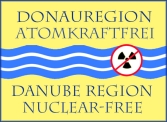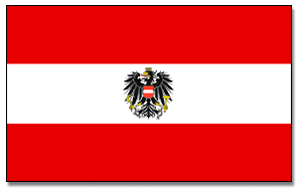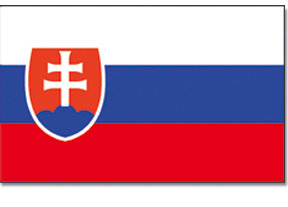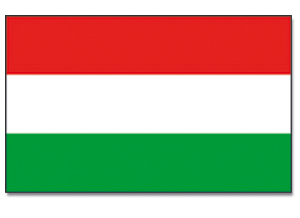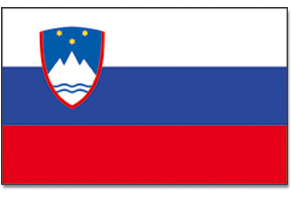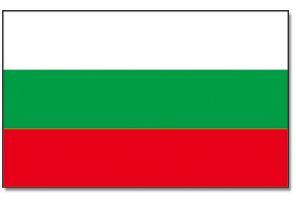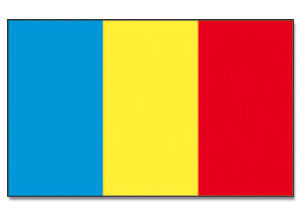Wissenswertes Basic Information
Um die neuesten Beiträge der Länder in Deutsch, Englisch und der Landessprache zu lesen, klicken Sie bitte auf die Flaggen
For the regional news in German, English and the language of the country click at the flags please
| Atomkraftwerke im Donauraum |
Stand Juli 2023 |
|
| Germany (Bayern) | alle Atomkraftwerke stillgelegt | Isar-1 stillgelegt, Isar-2 in Betrieb
außerdem laufen noch Emsland und Neckarwestheim |
| Czech Republik | Temelin 2 Blöcke in Betrieb Neu: 2 geplant |
Dukovany 4 Blöcke in Betrieb Neu: 2 geplant |
| Slovakia | Mochovce 2 in Betrieb, 2 in Bau |
Bohunice 2 Blöcke in Betrieb, 1 in Planung |
| Hungary | Paks 4 Blöcke in Betrieb, 2 in Planung (Umweltverträglichkeitsprüfung laufend) |
|
| Slovenia* | Krsko 1 Block in Betrieb, 1 in Planung |
|
| Bulgaria | Kosloduj 4 Blöcke stillgelegt, 2 in Betrieb |
Belene Planung auf Eis gelegt |
| Romania | Cernavoda 2 Blöcke in Betrieb, 2 im Baustopp, 1 Block storniert |
|
*Das Kernkraftwerk Krško [ˈkrʃkɔ] (slowenisch Jedrska elektrarna Krško (JEK), auch Nuklearna elektrarna Krško (NEK), kroatisch Nuklearna elektrana Krško) wurde in den 1970er Jahren im damaligen Jugoslawien erbaut und gehört jetzt jeweils zur Hälfte Kroatien und Slowenien. Offiziell wird das AKW von dem Unternehmen GEN energija d. o. o. in Krško betrieben. Wikipedia
-
-
-
-
- Genaue Angaben über die oben angeführten Atomkraftwerke finden Sie unter:
-
-
-
http://www.world-nuclear.org/info/Country-Profiles/
14 von 27 EU-Mitgliedsstaaten – also rund die Hälfte – betreiben derzeit keine eigenen Kernkraftwerke. Das geht aus Daten des österreichischen Umweltministeriums hervor, die sich unter anderem auf die Internationale Atomenergiebehörde IAEA beziehen. Spitzenreiter ist Frankreich mit 56 Reaktoren in Betrieb, dahinter folgt weit abgeschlagen Spanien mit 7 Reaktoren. Deutschland hat den letzten Meiler im April abgeschaltet. Großbritannien hat laut IAEA noch 11 AKWs am Netz. Mit insgesamt rund 110 Reaktoren stehen ein Viertel aller in Betrieb befindlichen Meiler weltweit in Europa.
An oder aus? Während Länder wie Deutschland aus der Atomenergie ausgestiegen sind, ist in Frankreich ein massiver Ausbau der Atomkraft geplant. Auch Großbritannien will am Atomstrom festhalten. Die Niederlande, Belgien, Bulgarien, Schweden und Tschechien haben den bereits geplanten Ausstieg verschoben und teilweise stattdessen Neubaupläne für AkWs aufgelegt.
Störfälle in den AKWs Temelin und Dukovany
http://www.anti.atom.at/index.php?page=stoerfaelle
Standort Dukovany
| Blocknr | Typ | Nettoleistung | Inbetriebnahme |
| 1 | Druckwasserreaktor WWER-440/213 | 427 MW | 02/1985 |
| 2 | Druckwasserreaktor WWER-440/213 | 427 MW | 01/1986 |
| 3 | Druckwasserreaktor WWER-440/213 | 427 MW | 11/1986 |
| 4 | Druckwasserreaktor WWER-440/213 | 427 MW | 06/1987 |
Alle Blöcke sind Hochrisikoreaktoren, kein Containment
Störfälle (Auswahl):
- 1994: Der Fehler eines Elektrikers führt zur Trennung vom Stromversorgungsnetz. Zwei Blöcke erreichen die Eigenversorgung, bei den zwei anderen müssen Notstromgeneratoren dies übernehmen, wobei einer manuell gestartet werden muss. Bei dem Störfall kommt es zu einer Reihe weiterer Fehler.
- 18. Februar 2010: Brand im Schalterraum
- 5. November 2014: Bei Bauarbeiten wird eine unterirdische Kühlleitung zerstört, Notabschaltung der Reaktoren 3 und 4
- 23. Juni 2015: Block 4: Undichtigkeit an Sekundärkreislauf, Abschaltung
- 23. Februar 2017: Block 2: Abschaltung nach Ventilproblemen im Druckwasser-Kreislauf, fünf Tage nach Revision
- Österreich: Volksabstimmung 1978
- 50,47% gegen Inbetriebnahme des AKW Zwentendorf
- Seither Antiatompolitik, Proteste gegen die Ausbaupläne in Ungarn, Slowakei, Slovenien und Tschechien nahe der österreichischen Grenzen.… mehr darüber auf www.atomkraftfreiezukunft.at
Liste von Unfällen in Kernanlagen weltweit
WPA / JN / 01/2019 Quelle: Wikipedia
|
1940er |
Los Alamos, New Mexico, Vereinigte Staaten |
21. August 1945 |
(INES: 4) |
|
Los Alamos, New Mexico, Vereinigte Staaten |
21. Mai 1946 |
(INES: 4) |
|
|
1950er |
Chalk River, Kanada |
12. Dezember 1952 |
(INES: 5) |
|
Idaho Falls, Idaho, Vereinigte Staaten |
29. November 1955 |
(INES: 4) |
|
|
Kyschtym, Sowjetunion (Majak) |
29. September 1957 |
(INES: 6) |
|
|
Windscale bzw. Sellafield, Großbritannien |
7.- 12. Oktober 1957 |
(INES: 5) |
|
|
Los Alamos, New Mexico, Vereinigte Staaten |
30. Dezember 1958 |
(INES: 4) |
|
|
Simi Valley, Kalifornien, Vereinigte Staaten |
26. Juli 1959 |
(INES: 5-6) |
|
|
Knoxville, Tennessee, Vereinigte Staaten |
20. November 1959 |
(INES: 3-4) |
|
|
1960er |
Idaho Falls, Idaho, Vereinigte Staaten |
3. Januar 1961 |
(INES: 4) |
|
Charlestown, Rhode Island, Vereinigte Staaten |
24. Juli 1964 |
(INES: 4) |
|
|
Belojarsk, Sowjetunion (Serie von Unfällen) |
1964-1979 |
(INES: 4) |
|
|
Melekess, nahe Nischnii Nowgorod (Gorki), Sowj. |
7. Mai 1966 |
(INES: 3-4) |
|
|
Monroe, Michigan, Vereinigte Staaten |
5. Oktober 1966 |
(INES: 4) |
|
|
Lucens, Schweiz |
21. Januar 1969 |
(INES: 4-5) |
|
|
Rocky Flats, Colorado, Vereinigte Staaten |
11. Mai 1969 |
(INES: 4-5) |
|
|
1970er |
Windscale bzw. Sellafield, Großbritannien |
1973 |
(INES 4) |
|
Leningrad, Sowjetunion |
6. Februar 1974 |
(INES 4-5) |
|
|
Leningrad, Sowjetunion |
Oktober 1974 |
(INES 4-5) |
|
|
Belojarsk, Sowjetunion |
1977 |
(INES 5) |
|
|
Jaslovské Bohunice, Tschechoslowakei |
Februar 1977 |
(INES 4) |
|
|
Belojarsk, Sowjetunion |
31. Dezember 1978 |
(INES 3-4) |
|
|
Three Mile Island, Pennsylvania, USA |
28. März 1979 |
(INES 5) |
|
|
1980er |
Saint-Laurent, Frankreich |
1980 |
(INES: 4) |
|
Tschernobyl, Sowjetunion |
September 1982 |
(INES: 5) |
|
|
Buenos Aires, Argentinien |
1983 |
(INES: 4) |
|
|
Wladiwostok, Sowjetunion |
August 1985 |
(INES: 5) |
|
|
Gore, Oklahoma, Vereinigte Staaten |
6. Januar 1986 |
(INES: 2–4) |
|
|
Tschernobyl, Sowjetunion |
26. April 1986 |
(INES: 7) |
|
|
1990er |
Sewersk, Russland |
6. April 1993 |
(INES: 2–4) |
|
Tōkai-mura, Japan |
30. September 1999 |
(INES 5) |
|
|
2000er |
Fleurus, Belgien |
11. März 2006 |
(INES: 4) |
|
2010er |
Fukushima, Japan |
11. März 2011 |
(INES: 7) |
Liste der Kernkraftwerke in Europa
Quellen: pris.iaea.org/PRIS/; de.wikipedia.org/wiki/Liste_der_Kernkraftwerke_in_Europa WPA/JN/02/19 1
|
Liste der Atomkraftwerke in Europa Stand: Februar 2019 |
||||
|
Land (Reaktoren insg.) |
AKW |
Anzahl der Reaktoren in Betrieb |
Jahr der Inbetriebnahme |
Geplante Abschaltung |
|
Belgien (7) |
Doel 1 – 4 |
4 |
’74, ’75, ’82, ’85 |
’25, ’25, ’22, ’25 |
|
Tihange 1 – 3 |
3 |
’75, ’82, ’85 |
’25, ’23, ’25 |
|
|
Bulgarien (2) |
Kosloduj 5, 6 |
2 |
’87, ’91 |
’27, ’23 |
|
Deutschland (7) |
Brokdorf |
1 |
’86 |
’21 |
|
Emsland |
1 |
’88 |
’22 |
|
|
Grohnde |
1 |
’84 |
’21 |
|
|
Gundremmingen C |
1 |
’84 |
’21 |
|
|
Isar 2 |
1 |
’88 |
’22 |
|
|
Neckarwestheim 2 |
1 |
’89 |
’22 |
|
|
Philippsburg 2 |
1 |
’84 |
’19 |
|
|
Finnland (4) |
Lovisa 1, 2 |
2 |
’77, ’80 |
’27, ’30 |
|
Olkiluoto 1, 2 |
2 |
’78, ’80 |
’39, ’42 |
|
|
Frankreich (58) |
Belleville 1, 2 |
2 |
’87, ’88 |
’28, ’29 |
|
Blayais 1 – 4 |
4 |
’81, ’82, ’83, ’83 |
’21, ’23, ’23, ’23 |
|
|
Bugey 2 – 5 |
4 |
’78, ’78, ’79, ’79 |
’19, ’19, ’19, ’20 |
|
|
Cattenom 1 – 4 |
4 |
’86, ’87, ’90, ’91 |
’27, ’28, ’31, ’32 |
|
|
Chinon B-1 – 4 |
4 |
’82, ’83, ’86, ’87 |
’24, ’24, ’27, ’28 |
|
|
Chooz B-1 – 2 |
2 |
’96, ’97 |
’37, ’39 |
|
|
Civaux 1, 2 |
2 |
’97, ’99 |
’37, ’39 |
|
|
Cruas 1 – 4 |
4 |
’83, ’84, ’84, ’84 |
’24, ’25, ’24, ’25 |
|
|
Dampierre 1 – 4 |
4 |
’80, ’80, ’81, ’81 |
’20, ’21, ’21, ’21 |
|
|
Fessenheim 1, 2 |
2 |
’77, ’77 |
’18, ’18‚ ‘20, ‘20 |
|
|
Flamanville 1, 2 |
2 |
’85, ’86 |
’26, ’27 |
|
|
Golfech 1, 2 |
2 |
’90, ’93 |
’31, ’34 |
|
|
Gravelines 1 – 6 |
6 |
’80, ’80, ’80, ’81, ’84, ’85 |
’20, ’20, ’21, ’21, ’25, ’25 |
|
|
Nogent 1, 2 |
2 |
’87, ’88 |
’28, ’29 |
|
|
Paluel 1 – 4 |
4 |
’84, ’84, ’85, ’86 |
’25, ’25, ’26, ’26 |
|
|
Penly 1, 2 |
2 |
’90, ’92 |
’30, ’32 |
|
|
St. Alban 1, 2 |
2 |
’85, ’86 |
’26, ’27 |
|
|
St. Laurent B-1 – 2 |
2 |
’81, ’81 |
’23, ’23 |
|
|
Tricastin 1 – 4 |
4 |
’80, ’80, ’81, ’81 |
’20, ’20, ’21, ’21 |
|
|
Großbritannien (15) |
Dungeness B-1 – 2 |
2 |
’83, ’85 |
’28, ’28 |
|
Hartlepool A-1 – 2 |
2 |
’83, ’84 |
’24, ’24 |
EUROPEAN UNION: Renewable energy statistics
The use of renewable energy has many potential benefits, including a reduction in greenhouse gas emissions, the diversification of energy supplies and a reduced dependency on fossil fuel markets (in particular, oil and gas). The growth of renewable energy sources may also have the potential to stimulate employment in the EU, through the creation of jobs in new ‘green’ technologies.
Primary production
The primary production of renewable energy within the EU-28 in 2014 was 196 million tonnes of oil equivalent (toe) — a 25.4 % share of total primary energy production from all sources. The quantity of renewable energy produced within the EU-28 increased overall by 73.1 % between 2004 and 2014, equivalent to an average increase of 5.6 % per year.
Among renewable energies, the most important source in the EU-28 was solid biofuels and renewable waste, accounting for just under two thirds (63.1 %) of primary renewables production in 2014. Hydropower was the second most important contributor to the renewable energy mix (16.5 % of the total), followed by wind energy (11.1 %). Although their levels of production remained relatively low, there was a particularly rapid expansion in the output of wind and solar energy, the latter accounting for a 6.1 % share of the EU-28’s renewable energy produced in 2014, while geothermal energy accounted for 3.2 % of the total. There are currently very low levels of tide, wave and ocean energy production, with these technologies principally found in France and the United Kingdom.
The largest producer of renewable energy within the EU-28 in 2014 was Germany, with an 18.4 % share of the total; Italy (12.1 %) and France (10.7 %) were the only other EU Member States to record double-digit shares, followed by Spain (9.2 %) and Sweden (8.5 %). There were considerable differences in the renewable energy mix across the Member States, which reflect to a large degree natural endowments and climatic conditions. For example, more than four fifths of the renewable energy produced in Malta (80.3 %) and around two thirds of that produced in Cyprus (66.7 %) was from solar energy. By contrast, close to or more than a third of the renewable energy in the relatively mountainous countries of Sweden, Croatia, Austria and Slovenia was from hydropower. Hydropower also accounted for more than a third of the renewable energy production in the former Yugoslav Republic of Macedonia, Serbia, and Montengro, rising to a share of almost two thirds Albania, while peaking at 90.1 % of the renewables energy total in Norway. More than one fifth (22.1 %) of the renewable energy production in Italy was from geothermal energy sources (where active volcanic processes exist); their share that rose to 78.7 % in Iceland. The share of wind power was particularly high in Ireland (51.8 %) and also accounted for close to or more than one quarter of renewable energy production in Spain, the United Kingdom and Denmark.
The output of renewable energy in Malta grew at an average rate of 41.3 % per year between 2004 and 2014, although the absolute level of output remained by far the lowest in the EU-28. Over this same period, annual increases averaging in excess of 10.0 % were recorded for Belgium (14.2 % per annum), the United Kingdom (12.7 %) and Ireland (11.7 %), while increases below 3.0 % were recorded in France, Romania, Latvia, Denmark, Sweden, Croatia and Finland.
Consumption
Renewable energy sources accounted for a 12.5 % share of the EU-28’s gross inland energy consumption in 2014 (see Table 2). The importance of renewables in gross inland consumption was relatively high in Portugal (25.0 %), Denmark (26.2 %), Finland (29.4 %) and Austria (30.0 %) and exceeded one third of inland consumption in Sweden (35.8 %) and Latvia (36.2 %), as was the case in Norway (44.8 %) and Iceland (86.3 %).
The EU seeks to have a 20 % share of its gross final energy consumption from renewable sources by 2020; this target is distributed between the EU Member States with national action plans designed to plot a pathway for the development of renewable energies in each of the Member States. Figure 1 shows the latest data available for the share of renewable energies in gross final energy consumption and the targets that have been set for 2020. The share of renewables in gross final energy consumption stood at 16.0 % in the EU-28 in 2014.
Among the EU Member States, the highest share of renewables in gross final energy consumption in 2014 was recorded in Sweden (52.6 %), while Latvia, Finland and Austria each reported that more than 30.0 % of their final energy consumption was derived from renewables. Compared with the most recent data available for 2014, the targets for France, the Netherlands and the United Kingdom require each of these Member States to increase their share of renewables in final energy consumption by at least 8.0 percentage points. By contrast, nine of the Member States had already surpassed their targets for 2020; this was particularly true in Croatia, Sweden and Bulgaria.
Electricity
The latest information available for 2014 (see Figure 2) shows that electricity generated from renewable energy sources contributed more than one quarter (27.5 %) of the EU-28’s gross electricity consumption. In Austria (70.0 %) and Sweden (63.3 %) at least three fifths of all the electricity consumed was generated from renewable energy sources, largely as a result of hydropower and solid biofuels.
The growth in electricity generated from renewable energy sources during the period 2004 to 2014 (see Figure 3) largely reflects an expansion in three renewable energy sources, namely, wind turbines, solar power and solid biofuels. Although hydropower remained the single largest source for renewable electricity generation in the EU-28 in 2014 (43.9 % of the total), the amount of electricity generated in this way in 2014 was relatively similar to that recorded a decade earlier, rising by just 12.1 % overall. By contrast, the quantity of electricity generated from solid biofuels (including renewable waste) and from wind turbines in 2014 was 1.8 times and 3.3 times as high as in 2004. The relative shares of wind turbines and solid biofuels in the total quantity of electricity generated from renewable energy sources rose to 27.4 % and 18.0 % respectively in 2014. The growth in electricity from solar power was even more dramatic, rising from just 0.7 TWh in 2004 to overtake geothermal energy in 2008, reaching a level of 92.3 TWh in 2014. Over this 10-year period, the contribution of solar power to all electricity generated from renewable energy sources rose from 0.1 % to 10.0 %. Tide, wave and ocean power contributed just 0.05 % of the total electricity generated from renewable energy sources in the EU-28 in 2014.
(source: http://ec.europa.eu/eurostat/statistics-explained/index.php/Renewable_energy_statistics)
